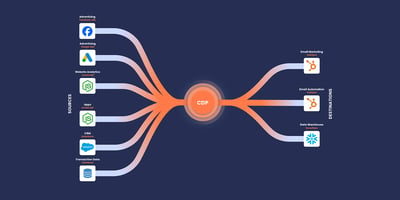What is Outbound Marketing?
Outbound marketing is interrupting.
"It's interrupting people with an email while they're at work; with a cold call; with an ad while they're watching their favourite TV show - it's irritating. And what's happened in society is that someone built up some, 'traffic', whether it's a podcast or a TV show - and you rent a little piece of their traffic. It's just working less and less. People's tolerance for it has gone down and their ability to block it has gone way up." - Brian Halligan CEO of HubSpot, Inc.
Bear in mind - there's nothing ineffective about the mediums used for outbound marketing (eg. Email, TV, LinkedIn campaigns, YouTube, Radio etc.), it's more about the content you put out there that defines your marketing as 'outbound'.
Examples that most clearly illustrate outbound marketing in its purest form include: purchased email lists; internal cold calling; and outsourced telemarketing. They all push messages 'out' far & wide, in hope of resonance with the target market.
"...outbound marketing techniques are getting less and less effective over time for two reasons. First, your average human today is inundated with over 2000 outbound marketing interruptions per day and is figuring out more and more creative ways to block them out, including caller ID, spam filtering or ad-blockers. Second, the cost of coordination around learning about something new or shopping for something new using the internet (search engines, blogs, and social media) is now much lower..." - Brian Halligan (CEO of HubSpot)
So then, out with the old and in with the Inbound...
What is Inbound Marketing?
'Being found' by your prospects is what inbound is all about. That way you're not interrupting them - you're helping them.
Market with a magnet, not a shotgun.
Inbound Marketing involves the production and syndication of 'magnetic' content designed to be interesting for your market and of course, lucrative for your business. That being said, to do effective Inbound Marketing you'll need 1) a clever Inbound content strategy and 2) a way to track your ROI...
1. Inbound Marketing Content
Essentially, content for an inbound strategy is completely considerate of the brand in question's market and what those individuals are likely to find helpful and engaging. And it's important to think outside the box here because the usual informative, pushy content pieces/ads aren't going to cut it.
Inbound Marketing Example
From here on out, we're going to refer to a fictional investment firm, DiviDen, switching from an outbound to an Inbound Marketing approach. This involves shifting budget away from content purely focussed on the various funds they offer and instead - DiviDen is now investing in a video series focussed on trends affecting the financial climate. And elaborating on how to keep your money on top of them.
Outbound content: DiviDen's fund offerings
VS.
Inbound content: Trends affecting financial climate
The shift to an Inbound methodology made the content a whole lot more relevant, helpful and sharable for their target market. Sidenote: they chose video marketing because brands that use video marketing grow their year-over-year revenue 49% faster than brands that don’t.
Supporting the production of the 'financial trends' video series, DiviDen use social media to syndicate the video content and link people to landing pages, which captures valuable information...
2. Inbound Marketing For ROI
Done right, Inbound Marketing usually involves landing pages featuring gated content offers. In other words, once DiviDen have earned their market's trust with the freely available video series, they'll include links to their landing page in the text captioning their video posts on social media platforms. Bear in mind, this is an example and there are a number of different ways to promote video content. The best way to get relevant people visiting a landing page will depend on the brand.
On the landing page, visitors are incentivised to give DiviDen their contact information with a valuable content asset. A free, but gated piece of content. As an example, the landing page might say: "You're one step closer to diving deeper into: 'How to: Stay on-trend and Raise Your Spending Power in 2019.' Please fill in your information and download our free infographic. We're asking not because we're going to 'spam' you - we're asking so that we have you on record and are able to assist you more efficiently if it comes to that."
DiviDen are still asking prospects for their contact information and tracking everything, but only after gaining their trust through valuable content. Luring people in with helpful, appealing content is part of what defines Inbound Marketing.
You know how reluctant you are to give your details before a brand has earned your trust. Not gonna happen, right?
Right. Adopting an Inbound Methodology is all about: Attract > Engage > Delight.
Sidenote: here is a video introducing how and why we embraced the Inbound Marketing methodology ourselves:





